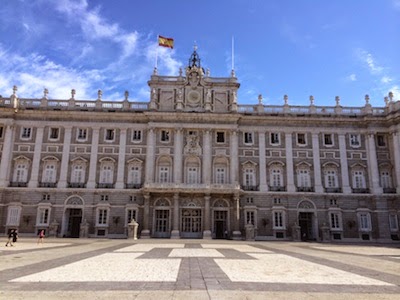
It seems a bold statement to make: how could Madrid’s Royal Palace possibly be better than France’s Versailles?
We were struck by all the clocks in the palace (pun most definitely intended): all but one we saw were actually working. These clocks are baroque works of art in themselves, with lavish gold and marble and silver and crystal, some with sculptures, all fairly accurate. That they were not only working but also displaying a reasonably correct time and wonderfully sounding off the quarter hour and (when you’re lucky) counting the top of the hours is a testament to the care and attention to detail Spain has placed in their Royal Palace.
The walls are real marble. If you look closely at the walls of Versailles, they’re faux marble: wood painted to look like they’re marble. The marble walls of Madrid’s Royal Palace are the real deal. And then there’s a room whose walls are fine porcelain. And many others so richly decorated or tapestried it’s hard to tell what they’re made of.
And then there’s the throne room…a spectacular “multimedia” explosion of baroque-rococo works of art, with bronze lions walking down from the thrones especially built for the reigning monarchs, where the frescoed ceiling “spills over” to the edges, painted figures becoming statues and interrupting the gold cornice, giving you the feeling that you are in the middle of the art, which, by the way, depicts in part Spain’s role in exploring and establishing the new world.
Throughout the palace are beautiful, elaborate crystal chandeliers, silver and gold fixtures, original furnishings, marble inlaid and “micromosaic” tables. There’s even a complete collection of Stradivarius strings–violins, violas, cellos–each worth up to $14M. Giving their Royal Palace to the people and proudly displaying the table at which King Juan Carlos signed the treaty allowing Spain to join the European Union is, I believe, a testament to their commitment to the modern day European state. While Versailles seems to revel in the glory of past France, Spain’s Royal Palace seems to tribute the past while relishing in the present and the future.
Outside the palace, across the massive courtyard, there is one of the finest armory museums in Europe. It is not the largest (we believe that would be the one in Paris), but it is an excellent display of armor, including dozens of full suits for horses displayed on life size horse mannequins (would that be “horsequins”?) and fifteen foot long muskets so unwieldy they had special little carriages for them, making them look like tiny little cannons.
So in this travel blog’s book, Madrid’s Royal Palace is indeed more impressive than Versailles.
A note on the lack of pictures: they don’t permit any photography within the Royal Palace, and unlike some, I’m one to (generally) obey those sorts of requests. At first I was going to gripe about this policy, but I found the experience of focusing on the palace sites and following our Rick Steves walking tour (instead of taking pictures) liberating. If you want to see pictures of some of what I mention above, you can always do a Google image search for Madrid’s Royal Palace.






